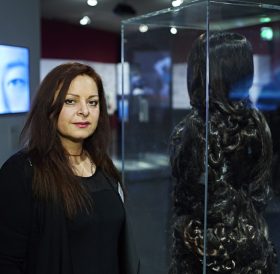Of Persian fairy tales and female self-determination

Artist Mandana Moghaddam standing next to her sculpture Chelgis I in the exhibition Cherchez la femme. Wig, Burqa, Wimple; Jewish Museum Berlin, photo: Yves Sucksdorff
In the course of the new exhibition Cherchez la femme – which deals with the covering of women within the idea of the monotheism of the three leading religions – we spoke with Iranian artist Mandana Moghaddam. Her artwork Chelgis (pronounced “Gelgis”) contributes to the concept of the exhibition in an impressive way and further stimulates the viewers’ own contemplation on the subject. Just in time for the exhibition’s opening we conducted a short interview with Mandana Moghaddam:
Dear Ms. Moghaddam, would you tell us a little bit about your artwork and the story of Chelgis?
I began my work by thinking of contemporary womens’ issues, examining them from different angles. When I drew the first sketch I saw the story of Chelgis – which means “40 braids” – right in front of me. It’s an old fairy tale which is part of the oral tradition of Persian speaking countries like Iran or Afghanistan: Chelgis actually is a girl who enters a beautiful garden. She finds herself trapped as the doors of the garden are closed and she can’t get out anymore. Soon she learns that there are demonic guardians who won’t let her leave. Meanwhile the people outside suffer as the water from the garden does no longer reach the villages. They desperately try to find a solution but nobody is able to kill the demons. The only way to end this misery is to find the bottle of life that’s hidden in the garden, and break it. With Chelgis is the only person in the garden she has to depend on herself.
This story mirrors women’s issues that I want to express by my artwork: The pressure on women from outside, the burden they often have to carry, and, of course, their strength to deal with all that.
In Arabic culture long dark hair reflects the idea of ideal beauty. Do people in Persia share the same perception?
Yes, they do. And not so long ago, every country in the world shared this beauty ideal, no matter if it was black, blond, or red hair. Alongside the modernization of societies there came more freedom for women, also in Iran, for they can decide by themselves if they want to cut their hair or not. Nowadays, I see more and more young women, especially in the cities, wearing short hair. I think that women in villages can’t cut their hair before they are married, but this trend is definitely coming to cities.
Would you say that things are changing for women in Iran, albeit at a very gradual pace?
Laws are one thing, people are another thing. Knowing the government of a country doesn’t mean that you know the people. They can be very distant from one another. Before the revolution in Iran women already had been able to go outside wearing whatever they liked. Now, the law says, a woman can’t go outside without wearing a shawl. This might have a bigger effect on less educated people. But you know what? Today 60 percent of university students are women.
That sounds like a “strong force” you can look forward to.
Strong, yes. In my hopelessness there is hope. (laughs)
The exhibition Cherchez la femme runs from 31 March – 2 July 2017.
For more information follow the link to our website: https://www.jmberlin.de/en/cherchez-la-femme
The interview was conducted by the curators of the exhibition, Miriam Goldmann and Katharina Erbe.